Having gotten our feet wet with the Wireshark packet sniffer in the introductory lab,
we’re now ready to use Wireshark to investigate protocols in operation. In this lab, we’ll explore several aspects of the HTTP protocol: the basic GET/response interaction, HTTP message formats, retrieving large HTML files, retrieving HTML files with embedded objects, and HTTP authentication and security. Before beginning these labs, you might want to review Section 2.2 of the text.1
1.The Basic HTTP GET/response interaction
Let’s begin our exploration of HTTP by downloading a very simple HTML file - one that is very short, and contains no embedded objects. Do the following:
- Start up your web browser.
- Start up the Wireshark packet sniffer, as described in the Introductory lab (but
don’t yet begin packet capture). Enter “http” (just the letters, not the quotation
marks) in the display-filter-specification window, so that only captured HTTP
messages will be displayed later in the packet-listing window. (We’re only
interested in the HTTP protocol here, and don’t want to see the clutter of all
captured packets). - Wait a bit more than one minute (we’ll see why shortly), and then begin
Wireshark packet capture. - Enter the following to your browser
http://gaia.cs.umass.edu/wireshark-labs/HTTP-wireshark-file1.html
Your browser should display the very simple, one-line HTML file. - Stop Wireshark packet capture.
Your Wireshark window should look similar to the window shown in Figure 1. If you
are unable to run Wireshark on a live network connection, you can download a packet trace that was created when the steps above were followed.
The example in Figure 1 shows in the packet-listing window that two HTTP messages were captured: the GET message (from your browser to the gaia.cs.umass.edu web server) and the response message from the server to your browser. The packet-contents window shows details of the selected message (in this case the HTTP OK message, which is highlighted in the packet-listing window). Recall that since the HTTP message was carried inside a TCP segment, which was carried inside an IP datagram, which was carried within an Ethernet frame, Wireshark displays the Frame, Ethernet, IP, and TCP packet information as well. We want to minimize the amount of non-HTTP data displayed (we’re interested in HTTP here, and will be investigating these other protocols is later labs), so make sure the boxes at the far left of the Frame, Ethernet, IP and TCP information have a plus sign or a right-pointing triangle (which means there is hidden, undisplayed information), and the HTTP line has a minus sign or a down-pointing triangle (which means that all information about the HTTP message is displayed).
(Note: You should ignore any HTTP GET and response for favicon.ico. If you see a reference to this file, it is your browser automatically asking the server if it (the server) has a small icon file that should be displayed next to the displayed URL in your browser. We’ll ignore references to this pesky file in this lab.).
By looking at the information in the HTTP GET and response messages, answer the
following questions. When answering the following questions, you should print out the GET and response messages (see the introductory Wireshark lab for an explanation of how to do this) and indicate where in the message you’ve found the information that answers the following questions. When you hand in your assignment, annotate the output so that it’s clear where in the output you’re getting the information for your answer (e.g., for our classes, we ask that students markup paper copies with a pen, or annotate electronic copies with text in a colored font).
- Is your browser running HTTP version 1.0 or 1.1? What version of HTTP is the
server running? - What languages (if any) does your browser indicate that it can accept to the
server? - What is the IP address of your computer? Of the gaia.cs.umass.edu server?
- What is the status code returned from the server to your browser?
- When was the HTML file that you are retrieving last modified at the server?
- How many bytes of content are being returned to your browser?
- By inspecting the raw data in the packet content window, do you see any headers
within the data that are not displayed in the packet-listing window? If so, name
one.
In your answer to question 5 above, you might have been surprised to find that the
document you just retrieved was last modified within a minute before you downloaded the document. That’s because (for this particular file), the gaia.cs.umass.edu server is setting the file’s last-modified time to be the current time, and is doing so once per minute. Thus, if you wait a minute between accesses, the file will appear to have been recently modified, and hence your browser will download a “new” copy of the document.
2. The HTTP CONDITIONAL GET/response interaction
Recall from Section 2.2.5 of the text, that most web browsers perform object caching and thus perform a conditional GET when retrieving an HTTP object. Before performing the steps below, make sure your browser’s cache is empty. (To do this under Firefox, select Tools->Clear Recent History and check the Cache box, or for Internet Explorer, select Tools->Internet Options->Delete File; these actions will remove cached files from your browser’s cache.) Now do the following:
• Start up your web browser, and make sure your browser’s cache is cleared, as
discussed above.
• Start up the Wireshark packet sniffer
• Enter the following URL into your browser
http://gaia.cs.umass.edu/wireshark-labs/HTTP-wireshark-file2.html
Your browser should display a very simple five-line HTML file.
Quickly enter the same URL into your browser again (or simply select the refresh
button on your browser)
• Stop Wireshark packet capture, and enter “http” in the display-filter-specification
window, so that only captured HTTP messages will be displayed later in the
packet-listing window.
• (Note: If you are unable to run Wireshark on a live network connection, you can
use the http-ethereal-trace-2 packet trace to answer the questions below; see
footnote 1. This trace file was gathered while performing the steps above on one
of the author’s computers.)
Answer the following questions:
8. Inspect the contents of the first HTTP GET request from your browser to the
server. Do you see an “IF-MODIFIED-SINCE” line in the HTTP GET?
9. Inspect the contents of the server response. Did the server explicitly return the
contents of the file? How can you tell?
10. Now inspect the contents of the second HTTP GET request from your browser to
the server. Do you see an “IF-MODIFIED-SINCE:” line in the HTTP GET? If
so, what information follows the “IF-MODIFIED-SINCE:” header?
11. What is the HTTP status code and phrase returned from the server in response to
this second HTTP GET? Did the server explicitly return the contents of the file?
Explain.
3. Retrieving Long Documents
In our examples thus far, the documents retrieved have been simple and short HTML
files. Let’s next see what happens when we download a long HTML file. Do the
following:
• Start up your web browser, and make sure your browser’s cache is cleared, as
discussed above.
• Start up the Wireshark packet sniffer
• Enter the following URL into your browser
http://gaia.cs.umass.edu/wireshark-labs/HTTP-wireshark-file3.html
Your browser should display the rather lengthy US Bill of Rights.
• Stop Wireshark packet capture, and enter “http” in the display-filter-specification
window, so that only captured HTTP messages will be displayed.
• (Note: If you are unable to run Wireshark on a live network connection, you can
use the http-ethereal-trace-3 packet trace to answer the questions below; see
footnote 1. This trace file was gathered while performing the steps above on one
of the author’s computers.)
In the packet-listing window, you should see your HTTP GET message, followed by a
multiple-packet TCP response to your HTTP GET request. This multiple-packet
response deserves a bit of explanation. Recall from Section 2.2 (see Figure 2.9 in the
text) that the HTTP response message consists of a status line, followed by header lines, followed by a blank line, followed by the entity body. In the case of our HTTP GET, the entity body in the response is the entire requested HTML file. In our case here, the HTML file is rather long, and at 4500 bytes is too large to fit in one TCP packet. The single HTTP response message is thus broken into several pieces by TCP, with each piece being contained within a separate TCP segment (see Figure 1.24 in the text). In recent versions of Wireshark, Wireshark indicates each TCP segment as a separate packet, and the fact that the single HTTP response was fragmented across multiple TCP packets is indicated by the “TCP segment of a reassembled PDU” in the Info column of the Wireshark display. Earlier versions of Wireshark used the “Continuation” phrase to indicated that the entire content of an HTTP message was broken across multiple TCP segments… We stress here that there is no “Continuation” message in HTTP!
Answer the following questions:
12. How many HTTP GET request messages did your browser send? Which packet
number in the trace contains the GET message for the Bill or Rights?
13. Which packet number in the trace contains the status code and phrase associated
with the response to the HTTP GET request?
14. What is the status code and phrase in the response?
15. How many data-containing TCP segments were needed to carry the single HTTP
response and the text of the Bill of Rights?
4. HTML Documents with Embedded Objects
Now that we’ve seen how Wireshark displays the captured packet traffic for large HTML
files, we can look at what happens when your browser downloads a file with embedded
objects, i.e., a file that includes other objects (in the example below, image files) that are
stored on another server(s).
Do the following:
• Start up your web browser, and make sure your browser’s cache is cleared, as
discussed above.
• Start up the Wireshark packet sniffer
• Enter the following URL into your browser
http://gaia.cs.umass.edu/wireshark-labs/HTTP-wireshark-file4.html
Your browser should display a short HTML file with two images. These two
images are referenced in the base HTML file. That is, the images themselves are
not contained in the HTML; instead the URLs for the images are contained in the
downloaded HTML file. As discussed in the textbook, your browser will have to
retrieve these logos from the indicated web sites. Our publisher’s logo is
retrieved from the gaia.cs.umass.edu web site. The image of the cover for our 5th
edition (one of our favorite covers) is stored at the caite.cs.umass.edu server.
(These are two different web servers inside cs.umass.edu).
• Stop Wireshark packet capture, and enter “http” in the display-filter-specification
window, so that only captured HTTP messages will be displayed.
• (Note: If you are unable to run Wireshark on a live network connection, you can
use the http-ethereal-trace-4 packet trace to answer the questions below; see
footnote 1. This trace file was gathered while performing the steps above on one
of the author’s computers.)
Answer the following questions:
16. How many HTTP GET request messages did your browser send? To which
Internet addresses were these GET requests sent?
17. Can you tell whether your browser downloaded the two images serially, or
whether they were downloaded from the two web sites in parallel? Explain.
5 HTTP Authentication
Finally, let’s try visiting a web site that is password-protected and examine the sequence of HTTP message exchanged for such a site. The URL
http://gaia.cs.umass.edu/wireshark-labs/protected_pages/HTTP-wireshark-file5.html is password protected. The username is “wireshark-students” (without the quotes), and the password is “network” (again, without the quotes). So let’s access this “secure”
password-protected site. Do the following:
• Make sure your browser’s cache is cleared, as discussed above, and close down
your browser. Then, start up your browser
• Start up the Wireshark packet sniffer
• Enter the following URL into your browser
http://gaia.cs.umass.edu/wireshark-labs/protected_pages/HTTP-wiresharkfile5.html
Type the requested user name and password into the pop up box.
• Stop Wireshark packet capture, and enter “http” in the display-filter-specification
window, so that only captured HTTP messages will be displayed later in the
packet-listing window.
• (Note: If you are unable to run Wireshark on a live network connection, you can
use the http-ethereal-trace-5 packet trace to answer the questions below; see
footnote 2. This trace file was gathered while performing the steps above on one
of the author’s computers.)
Now let’s examine the Wireshark output. You might want to first read up on HTTP
authentication by reviewing the easy-to-read material on “HTTP Access uthentication Framework” at http://frontier.userland.com/stories/storyReader$2159
Answer the following questions:
18. What is the server’s response (status code and phrase) in response to the initial
HTTP GET message from your browser?
19. When your browser’s sends the HTTP GET message for the second time, what
new field is included in the HTTP GET message?
The username (wireshark-students) and password (network) that you entered are encoded in the string of characters (d2lyZXNoYXJrLXN0dWRlbnRzOm5ldHdvcms=) following
the “Authorization: Basic” header in the client’s HTTP GET message. While it
may appear that your username and password are encrypted, they are simply encoded in a format known as Base64 format. The username and password are not encrypted! To see this, go to http://www.motobit.com/util/base64-decoder-encoder.asp and enter the
base64-encoded string d2lyZXNoYXJrLXN0dWRlbnRz and decode. Voila! You have
translated from Base64 encoding to ASCII encoding, and thus should see your username! To view the password, enter the remainder of the string Om5ldHdvcms= and press
decode. Since anyone can download a tool like Wireshark and sniff packets (not just
their own) passing by their network adaptor, and anyone can translate from Base64 to ASCII (you just did it!), it should be clear to you that simple passwords on WWW sites are not secure unless additional measures are taken.
Fear not! As we will see in Chapter 8, there are ways to make WWW access more secure.However, we’ll clearly need something that goes beyond the basic HTTP authentication framework!
(一) Ethereal(或WireShark)的使用
- 你主机的IP地址是什么?你所访问的主页所在服务器的IP地址是什么?
192.168.1.112 183.36.114.45 - 写出两个第9步所显示的HTTP消息头部行信息。


(二)HTTP分析
-
你的浏览器使用的是HTTP1.0,还是HTTP1.1?你所访问的Web服务器所使用HTTP协议的版本号是多少?
HTTP 1.1 Version 4 -
你的浏览器向服务器指出它能接收何种语言版本的对象?
Zh-CNrn
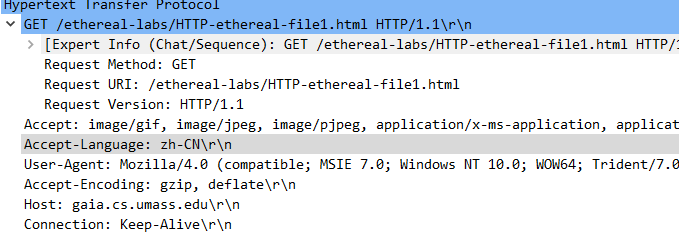
-
你的计算机的IP地址是多少?服务器gaia.cs.umass.edu的IP地址是多少?
计算机IP地址:192.168.1.147
服务器IP地址:128.119.245.12

-
从服务器向你的浏览器返回response消息的状态代码是多少?
200 OK -
你从服务器上所获取的HTML文件的最后修改时间是多少?
Mon,12 Oct 2020 05:59:02 GMT

-
返回到浏览器的内容一共多少字节?
126 bytes

-
分析你的浏览器向服务器发出的第一个HTTP GET请求的内容,在该请求消息中,是否有一行是:IF-MODIFIED-SINCE?
无

-
分析服务器响应消息的内容,服务器是否明确返回了文件的内容?如何获知?
是
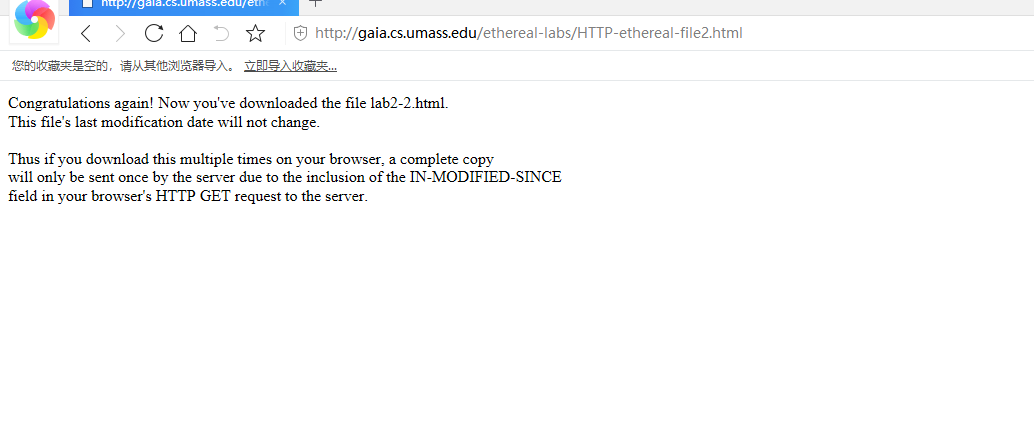
-
分析你的浏览器向服务器发出的第二个“HTTP GET”请求,在该请求报文中是否有一行是:IF-MODIFIED-SINCE?如果有,在该首部行后面跟着的信息是什么?
有 Mon,12 Oct 2020 05:59:02

-
服务器对第二个HTTP GET请求的响应消息中的HTTP状态代码是多少?服务器是否明确返回了文件的内容?请解释。
状态代码: 304
没有返回文件内容 服务器只是返回了一个响应的报文


-
你的浏览器一共发出了多少个HTTP GET请求消息?
1个http get请求消息。 -
承载这一个HTTP响应报文一共需要多少个TCP报文段?
-
与这个HTTP GET请求相对应的响应报文的状态代码和状态短语是什么?
200 OK

-
在被传送的数据中一共有多少个HTTP状态行?
2个
-
你的浏览器一共发出了多少个HTTP GET请求消息?这些请求消息被发送到的目的地IP地址是多少?
有4个HTTP GET请求消息,分别是128.119.245.12 , 165.193.123.218 , 128.119.240.90和165.193.140.24

-
浏览器在下载这两个图片时,是串行下载还是并行下载?请解释。
串行下载,因为下载图片时,进行了两次请求。

-
对于浏览器发出的、最初的HTTP GET请求消息,服务器的响应消息的状态代码和状态短语分别是什么?
状态代码:Description:OK;状态短语:200 (请求成功)

-
当浏览器发出第二个HTTP GET请求消息时,在HTTP GET消息中包含了哪些新的头部行?

-
定位到DNS查询消息和查询响应报文,这两种报文的发送是基于UDP还是基于TCP的?
UDP

-
DNS查询消息的目的端口号是多少?DNS查询响应消息的源端口号是多少?
目的端口53,源端口:56312

-
DNS查询消息发送的目的地的IP地址是多少?利用ipconfig命令(ipconfig/all)查看你主机的本地DNS服务器的IP地址。这两个地址相同吗?
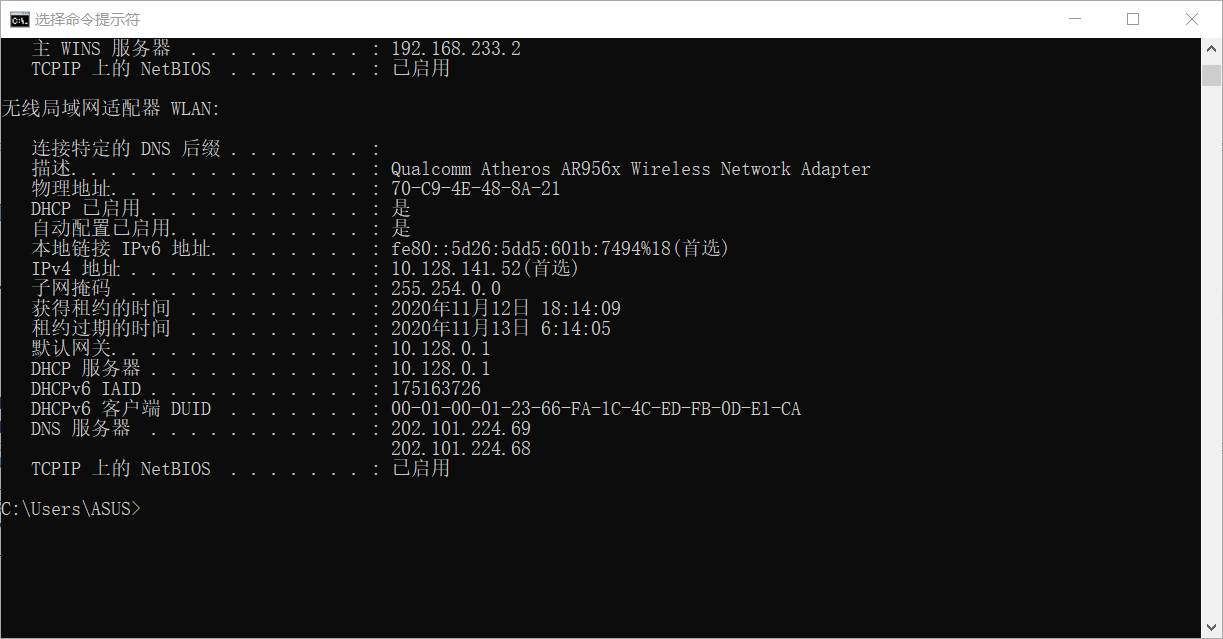

这两个地址是一样的。
22. 检查DNS查询消息,它是哪一类型的DNS查询?该查询报文中包含“answers”吗?

该报文是ipv6地址型的DNS查询,里面没有包含answers。
23. 检查DNS查询响应消息,其中共提供了多少个“answers”?每个answers包含哪些内容?

提供了一个answers,里面的信息如上。
- 考虑一下你的主机随后发送的TCP SYN Segment, 包含SYN Segment的IP分组头部中目的IP地址是否与在DNS查询响应消息中提供的某个IP地址相对应?
相对应的,TCP的目的IP和DNS的某个响应IP对应
- 打开的WEB页中包含图片,在获取每一个图片之前,你的主机发出新的DNS查询了吗?
没有 - DNS查询消息的目的端口号是多少?DNS查询响应消息的源端口号是多少?

端口号是53,源端口号是56312.
27. DNS查询消息发送的目的地的IP地址是多少?这个地址是你的默认本地DNS服务器的地址吗?


这两个IP是一样的,都是202.101.224.69
28. 检查DNS查询消息,它是哪一类型的DNS查询?该查询消息中包含“answers”吗?

域名指针类型,没有answers
29. 检查DNS查询响应消息,其中提供了多少个“answers”?每个answers包含哪些内容?

包含一个
30. DNS查询消息发送的目的地的IP地址是多少?这个地址是你的默认本地DNS服务器的地址吗?
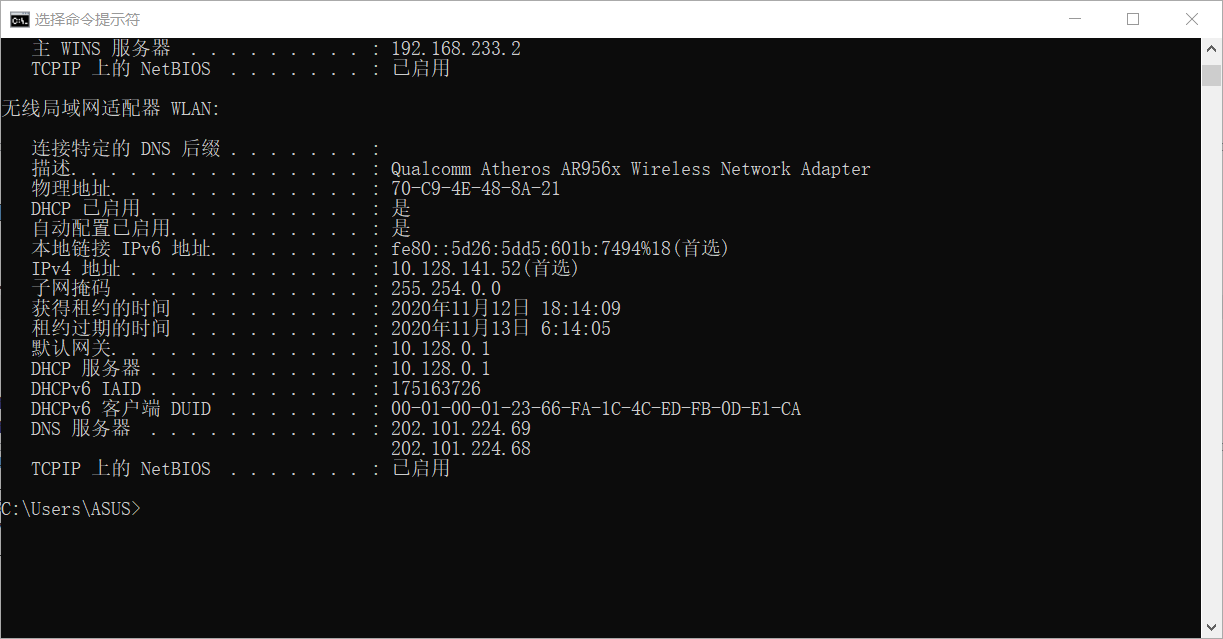

是我默认的DNS服务器地址202.101.224.69
31. 检查DNS查询消息,它是哪一类型的DNS查询?该查询报文中包含“answers”吗?

域名指针类型,含有answers
32. 检查DNS查询响应消息,其中响应消息提供了哪些MIT名称服务器?响应消息提供这些MIT名称服务器的IP地址了吗?
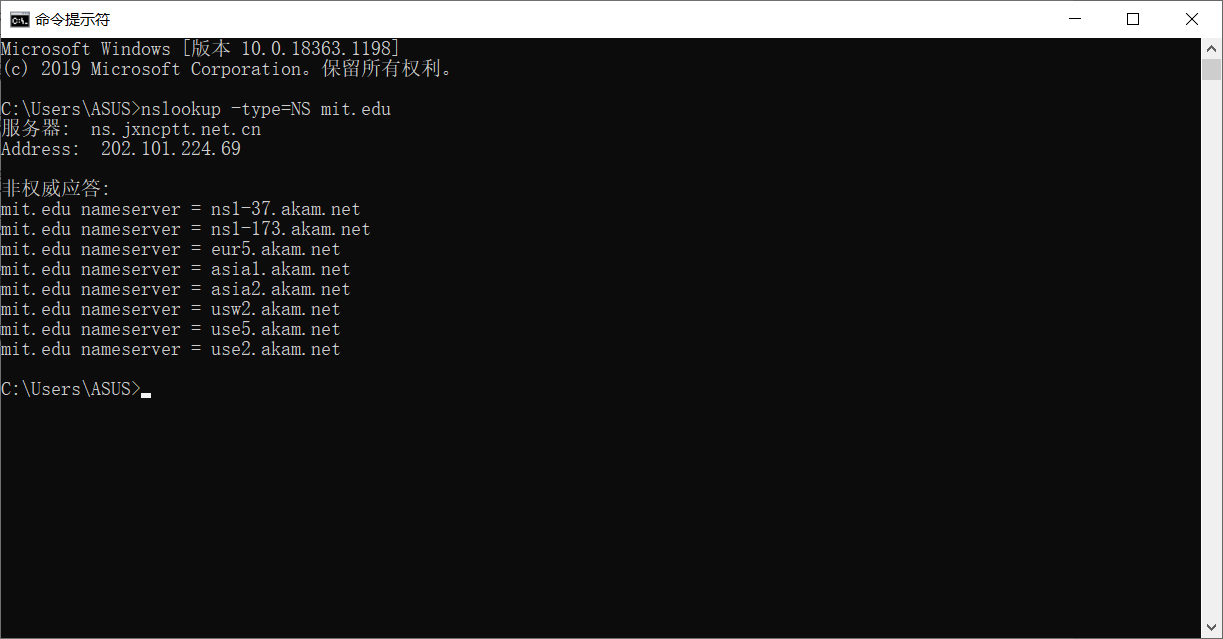
- DNS查询消息发送的目的地的IP地址是多少?这个地址是你的默认本地DNS服务器的地址吗?如果不是,这个IP地址相当于什么?

不是,这个IP地址相当于中转DNS的IP,中转完以后再进行传递。
34. 检查DNS查询消息,它是哪一类型的DNS查询?该查询报文中包含“answers”吗?
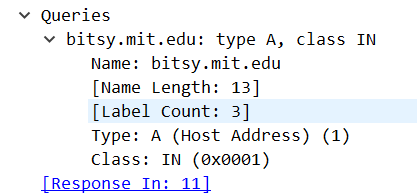
它是主机地址的DNS查询,里面不含有answers。
35. 检查DNS查询响应消息,其中提供了多少个“answers”?每个answers包含哪些内容?
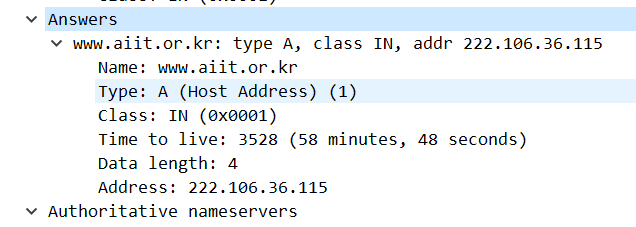
里面只有一个answers
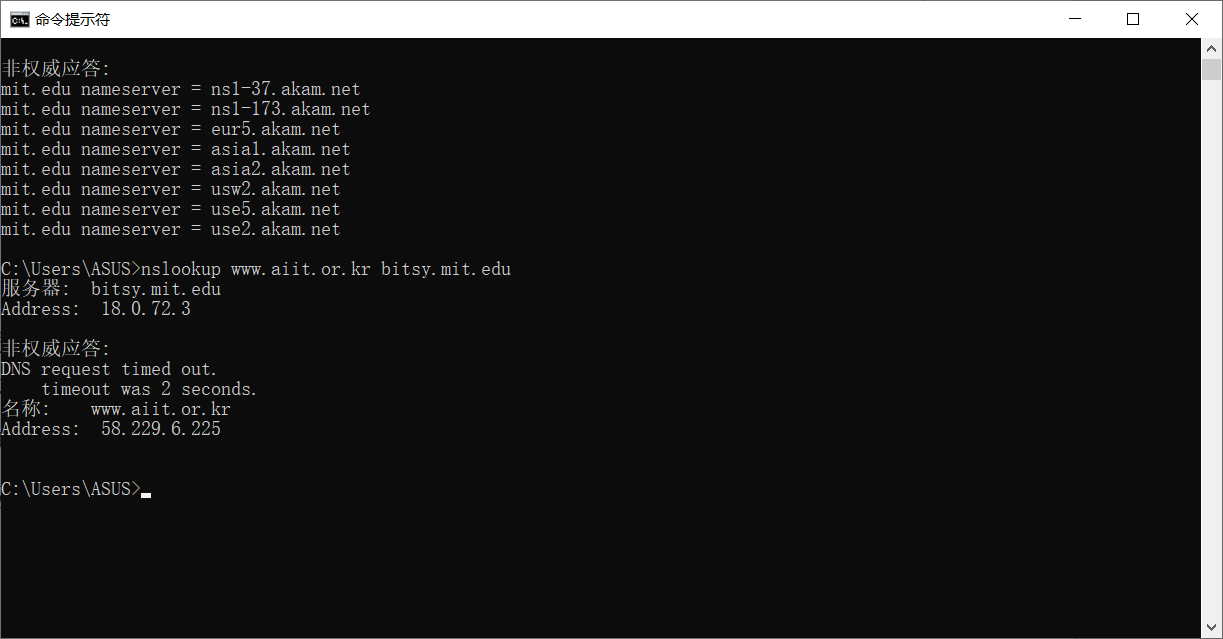
最后
以上就是老迟到乐曲最近收集整理的关于实验3 利用分组嗅探器分析HTTP和DNS的全部内容,更多相关实验3内容请搜索靠谱客的其他文章。








发表评论 取消回复